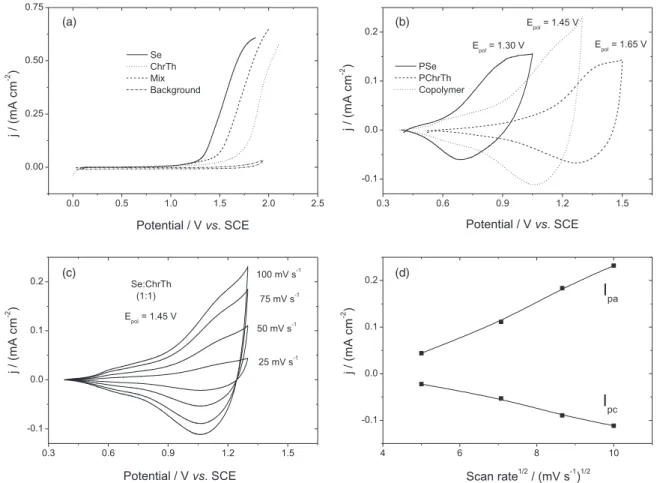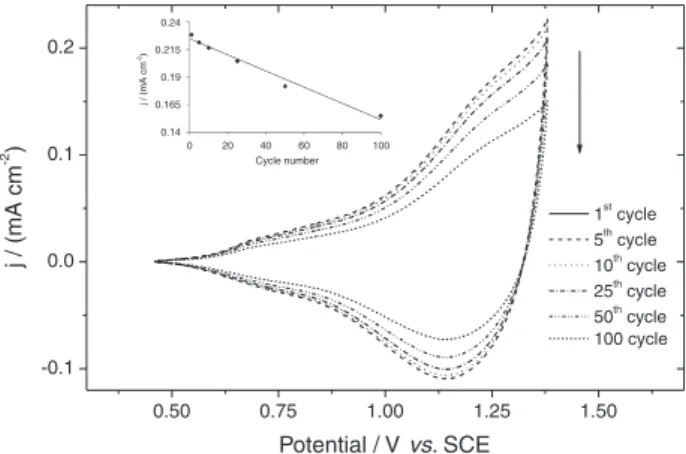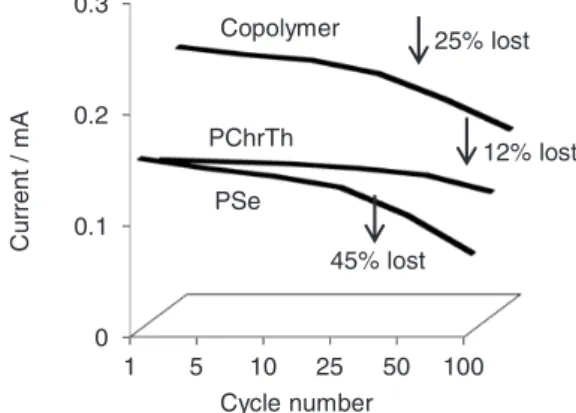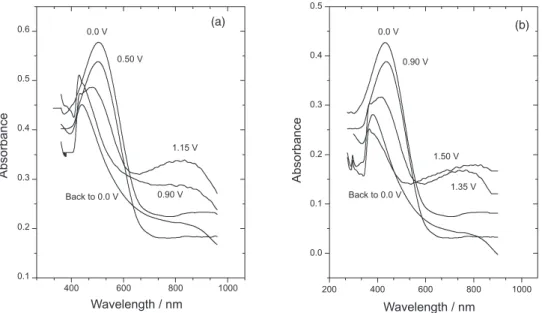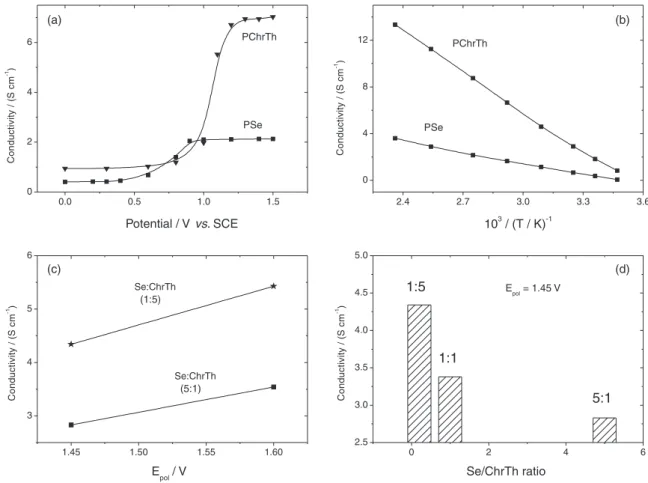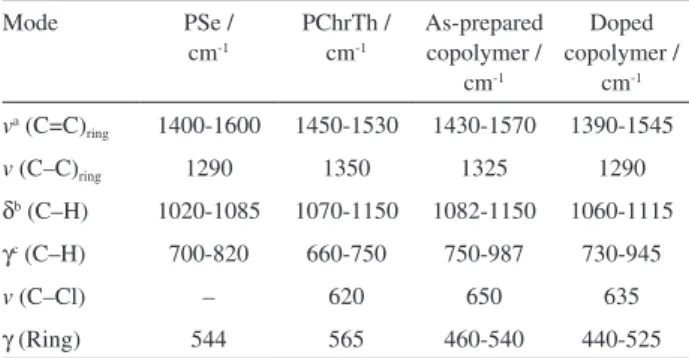Article
Printed in Brazil - ©2016 Sociedade Brasileira de Química0103 - 5053 $6.00+0.00*e-mail: falakhras@uod.edu.sa
Spectroelectrochemistry of Intrinsically Conducting
Selenophene-3-Chlorothiophene Copolymers
Fadi Alakhras*
Department of Chemistry, College of Science, University of Dammam, 31441 Dammam, Saudi Arabia
The electrochemical copolymerization between selenophene and 3-chlorothiophene monomers was successfully realized. The influence of the applied polymerization potential and the monomer feed ratio on the copolymer properties were investigated, and the results revealed that the obtained polymer films strongly depended on the polymerization conditions. The obtained copolymers showed good redox stability in acetonitrile-based electrolyte solution. Band gap energy of the homo- and copolymer films was estimated and the values were between 1.95-2.11 eV. The electrical conductivity measurements of selenophene-3-chlorothiophene copolymers were successfully achieved using a four-probe technique and generally increased with increasing temperature. Fourier transform infrared (FTIR) characterization disclosed that the bands of homopolymers were retained in the spectra of copolymers with typical assignments suggesting that α-positions in the polymer chains were involved in the polymerization.
Keywords: poly(3-chlorothiophene), polyselenophene, electropolymerization, in situ UV-Vis spectroscopy, redox stability
Introduction
Since the synthesis of highly conducting doped-polyacetylene,1 conducting polymers have generated significant research interest and have become a rapidly growing field in chemistry.2 The great importance of these materials is their ability to conduct electric current after being partially p-doped or n-doped.
The characteristics of conductive films are mainly dependent on the electropolymerization conditions. Furthermore, different composition of heteroatoms in similar systems can vary significantly in their electrical properties, chemical stability and simplicity of polymerization.
In spite of the similarity in chemistry between selenophene and thiophene rings,3-6 very little is known about selenophene-based polymers even though efforts have lately been made to use them instead of polythiophene in optoelectronics applications.7,8
Polyselenophene has been synthesized previously. Its chemical, electrochemical and optical properties are investigated.6,9-14 However, the quality of the obtained film was “not too good”. Also, the conductivity of doped polyselenophenes ranges from 10-4 to 10-1 S cm-1,3 which
is remarkably lower than the conductivity of doped polythiophenes (up to 1000 S cm-1).
Thiophene-based polymers are very stable in its oxidized form which makes these systems one of the most studied conducting polymers.15,16 Much interest has been generated toward substituted polythiophenes. Integration of substitutions in the monomers influences appreciably the properties of the obtained polymer films.17-19 Poly(3-halide thiophene)s have been also studied and investigated.20-22 In particular, poly(3-chlorothiophene) (PChrTh) films have been obtained potentiostatically by direct oxidation of 3-chlorothiophene (ChrTh) in mixed electrolytes of boron trifluoride diethyl etherate (BFEE) and trifluoroacetic acid (TFA) or sulfuric acid (SA).23,24 Using of such superacid decreases the oxidation potential of the monomer and improves the general quality of the polymer films.
Copolymerization is a useful technique to overcome the weaknesses in mechanical, physical and chemical properties of conducting polymers. These kinds of copolymer materials have been considered recently and have been found to reveal potentially useful electrochromic properties and improved features in terms of conductivity and redox stability.25-28
electro-optical properties of the copolymers showed intermediate characteristics between the homopolymer films.29
The lack of synthetic methodologies to obtain substituted selenophene-based monomeric precursors is a major key to remain polyselenophenes practically unexplored.30 Therefore, further improvement in mechanical, physical and chemical properties of selenophene-based polymer films can be attained through copolymerization process. Very recently in our lab, poly(selenophene-co-thiophene) films have been achieved electrochemically. The redox stability and electrical conductivity of polyselenophene by copolymerization with thiophene monomer units have been remarkably improved.31-33
According to our knowledge, there are no reports concerning the electrochemical behavior of selenophene-3-chlorothiophene copolymer films. In this paper, we report on the electrochemical copolymerization of selenophene and 3-chlorothiophene in mixed solvent system consisting of BFEE + EE (ethyl ether) (2:1) with 10% of TFA (v:v). The spectroelectrochemical properties of the obtained copolymers are investigated and are compared with the pristine homopolymers.
Experimental
Selenophene (TCI, 98%) and 3-chlorothiophene (Oakwood, 98%) were distilled under nitrogen just prior to use. Ethyl ether (Fisher Scientific) was dried and distilled in the presence of sodium. Boron trifluoride-ethyl ether (BFEE; Acros, NJ, United State, 48% BF3) was used as received. Tetrabutylammonium tetrafluoroborate (TBATFB; Acros, Geel, Belgium, 98%) was dried under vacuum at 80 oC for 24 h. Acetonitrile (Merck, anhydrous, < 10 ppm H2O) and trifluoroacetic acid (TFA; Thermo Scientific, NJ, United State, 99.5%) were used without further purification.
The electrochemical polymerizations between selenophene and 3-chlorothiophene were carried out in a one-compartment three-electrode cell by using a 150 potentiostat - galvanostat (Bio-Logic, Claix, France) under computer control EC-Lab software. A platinum disc electrode (area 0.1 cm2) was used as working electrode for electrosynthesis and cyclic voltammetry (CV) measurements; where as a platinum wire was used as counter electrode. Saturated calomel electrode (SCE) was used as reference electrode. The process was carried out potentiostatically in BFEE + EE (2:1, v/v) solution containing 0.1 mol L-1 TBATFB as supporting electrolyte at room temperature at constant electrode potential for 2 min. After polymerization, the film was washed with acetonitrile to remove any traces of mono- and oligomers. CV of the obtained polymers was carried out in a monomer
free acetonitrile solution containing a 0.1 mol L-1 TBATFB as supporting electrolyte. All solutions were deaerated by a dry N2 stream for 10 min before the experiment and a slight N2 over-pressure was maintained during the experiment.
The in situ UV-Vis spectra were recorded with the homo- and copolymer films deposited on a modified optically transparent ITO glass electrode (area 3 cm2) in the supporting electrolyte solution (acetonitrile + 0.1 mol L-1 TBATFB) in a standard 10 mm cuvette using a UV-Visible spectrophotometer Shimadzu UV 1800-PC instrument (Kyoto, Japan), resolution 1 nm. A cuvette with the same solution and an uncoated ITO glass was placed in the reference beam. Spectra were recorded at increasingly positive electrode potentials using the CVs to determine the suitable range of electrode potentials. The absorption maximum λ1max assigned to the π → π* transition was measured with the polymer in its neutral state. Where as the absorption maximum λ2max assigned to an intraband transition from the valence band into the upper bipolaron band of the polymer was conducted in its oxidized form.
Conductivity measurements were performed using a four-probe technique (SES Instruments Pvt. Ltd., Roorkee, India). The homo- and copolymer films were deposited onto a platinum sheet electrode. After p-doping to desired potentials (up to E / V vs. SCE = 1.50 V) in acetonitrile monomer free solution, the deposited films were scraped off from the electrode surface, dried and then pressed to discs with relatively thin thickness.
For Fourier transform infrared spectroscopy (FTIR) spectroscopy measurements, the pristine films were scraped off from the electrode and dried. FTIR spectra of the homo- and copolymer films using KBr-discs were recorded on Shimadzu FTIR 8400 spectrometer (Duisburg, Germany) at 2 cm-1 resolution.
Results and Discussion
Electrosynthesis and electrochemical behavior
The anodic polarization curves of monomers in a binary solvent system consisting of BFEE + EE (2:1, v/v) solutions containing 0.1 mol L-1 TBATFB are displayed in Figure 1a. The background electrolyte solution is electrochemically silent in the whole potential range.
TBATFB (2.18 V vs. SCE).23 Boron trifluoride-ethyl ether (BFEE) complex was used as a binary system to anodic oxidative polymerization of various aromatic monomers.34-36 It has been suggested that the potential-lowering effect of BFEE on the electrosynthesis of polymers results from the interaction of BFEE and monomer rings, thus lowering the aromatic resonance energy of the rings. The addition of TFA (10%, v/v) to BFEE + EE (2:1, v/v) may lead to the formation of π complexes between the monomers and the strong acid and can also increase the conductivity of the electrolyte appreciably.23,29 Consequently, further decreases of the oxidation potential of the monomers, and the obtained polymer films have well-defined conjugated structures and good mechanical properties. The small difference between the oxidation potentials of the two monomers suggests a large probability of copolymerization between them. A current-potential curve was obtained for a solution containing 0.1 mol L-1 selenophene and 0.1 mol L-1 3-chlorothiophene. The oxidation potential of the mixture started at E vs. SCE = 1.45 V, which is between the oxidation potentials of the two monomers. Consequently, the oxidation of both monomers is expected and the copolymer chains may accordingly be composed of selenophene and 3-chlorothiophene units.31,32
After two minutes of applying polymerization potential, the CVs of the obtained polymer films have been measured in a monomer free acetonitrile solution containing a 0.1 mol L-1 TBATFB as supporting electrolyte. Figure 1b shows the CVs of polyselenophene and poly(3-chlorothiophene), respectively. Polyselenophene has a broad anodic peak at E vs. SCE = 0.92 V caused by polymer oxidation and a consequent broad cathodic peak around E vs. SCE = 0.70 V due to polymer reduction. This steady-state CV is similar to the results reported before.3,31 For poly(3-chlorothiophene), the respective peaks are at E vs. SCE = 1.35 V and 1.28 V, with a difference of 0.07 V indicates a high reversibility of the associated redox processes. Copolymerization is carried out at constant electrode potentials. Figure 1b reveals also a typical CV of a copolymer obtained from solution containing 0.1 mol L-1 selenophene and 0.1 mol L-1 3-chlorothiophene prepared at E vs. SCE = 1.45 V. The copolymer shows one anodic/ cathodic peak couple at a position quite different from the positions observed with the homopolymer films. The appearance of one redox peak indicates uniform redox properties. Apparently, both the cathodic and the anodic current are higher than those found with the pristine
0.0 0.5 1.0 1.5 2.0 2.5
0.00 0.25 0.50 0.75
(a)
Se ChrTh Mix Background
Potential / Vvs. SCE
0.3 0.6 0.9 1.2 1.5
-0.1 0.0 0.1 0.2
Epol= 1.65 V Epol= 1.45 V
Epol= 1.30 V
PSe PChrTh Copolymer
(b)
Potential / Vvs. SCE
25 mV s-1 50 mV s-1
Potential / Vvs. SCE
j
/
(m
A
c
m
-2 )
j
/
(m
A
c
m
-2 )
j
/
(m
A
c
m
-2 )
0.3 0.6 0.9 1.2 1.5
-0.1 0.0 0.1 0.2
Epol= 1.45 V Se:ChrTh
(1:1)
(c)
75 mV s-1 100 mV s-1
4 6 8 10
-0.1 0.0 0.1 0.2 (d)
I
pc
I
pa
Scan rate1/2/ (mV s-1)1/2
j
/
(m
A
c
m
-2 )
homopolymers indicating that the redox capacity and the amount of deposited copolymer is higher after the same time of polymerization.26 The broad redox waves existing in the CVs of the homo- and copolymer films are explained by the diffusion of the dopant ions in and out of the polymer films as well as to some coupling defects which are distributed statically and are appeared in a series of energetically nonequivalent chain segments.37,38 Moreover, the CVs of the homo and copolymer films are not measured within the same potential range due to the effect of overoxidation process. The degradation and overoxidation of conducting polymers is a complex process related to different purposes. With polythiophene, it proceeds mostly at electrode potentials positive to the range wherein deposition and reversible redox cycling take place. As a result, the reversible redox processes and the irreversible degradation process can be distinguished clearly. In the case of polyselenophene, the degradation process might take place in the same potential range in which the reversible redox process occurs (oxidized from its neutral to doped state). Using copolymerization technique between 3-chlorothiophene and selenophene monomers can increase the film stability from overoxidation and irreversible degradation. However, some irreversible processes still exist in the obtained copolymers.
Figures 1c and 1d shows CVs at different scan rates ranging from dE/dt = 25-100 mV s-1 of copolymer film obtained at E vs. SCE = 1.45 V. The redox currents are mainly dependent on the square root of the scan rate which indicates that the electrochemical processes are diffusion-controlled and a redox couple is attached to the electrode.24,26,31
Electrochemical copolymerization both at different polymerization potentials and with different monomer concentrations has been investigated. The data in Table 1 shows that the redox peak potentials of the copolymers shift to higher values with increasing polymerization potential of the copolymer films.
The results point out that keeping the polymerization potential of copolymers obtained in mixed solutions near the threshold potential of ChrTh may result in
ChrTh-based copolymers and vice versa. Moreover,
when the concentration of ChrTh is increased in the polymerization solution a positive shift of the redox potentials of the copolymers is observed. This implies that more ChrTh units are integrated into the copolymer film when its concentration in the feed increases.
Redox stability of homo- and copolymer films
Comparing with homopolymers, selenophene-3-chlorothiophene copolymer films confirm a good long-term stability of redox activity after cycling in dry acetonitrile. As shown in Figure 2, the peak separation of redox couple is between 0.06-0.19 V which may conclude that the process is considered to be reversible, i.e., fast with some irreversibility occurred during cycling specially with selenophene polymer films. This behavior is a common feature and is usually observed in the electrochemistry of intrinsically conducting polymers.32,38
The obtained copolymer films can be cycled frequently between the oxidized and neutral state with slight decrease in its electroactivity. The retention of the redox activity of the copolymer film after 100 times cycling in dry acetonitrile is about 65% (in terms of current density), indicating the coexistence of both long and short conjugation lengths in the copolymer chains.
Additionally the stability of the copolymer film declined sharply after exceeding 25 cycles and lost 25% of its redox capacity, while polyselenophene lost 45% beyond 25 cycles (Figure 3). The copolymers are more stable and less affected than polyselenophene by frequent cycling most probably due to the existence of 3-chlorothiophene units in the copolymer chains which may increase the stability of the material film. This observation demonstrates that the degradation of conjugated structures occurs
Table 1. Peak potentials of copolymers prepared at E vs. SCE = 1.45 and 1.60 V from BFEE + EE (2:1) with 10% of TFA (v/v) solutions containing different monomer feed ratio
Se/ChrTh (mole ratio)
Epol = 1.45 V Epol = 1.60 V
Epa / V Epc / V Epa / V Epc / V
1:1 1.11 1.06 1.19 1.15
5:1 1.01 0.93 1.08 0.99
1:5 1.25 1.18 1.30 1.24
0.50 0.75 1.00 1.25 1.50
-0.1 0.0 0.1 0.2
1st
cycle 5thcycle 10thcycle 25th
cycle 50th
cycle 100 cycle
0.14 0.165 0.19 0.215 0.24
0 20 40 60 80 100
Cycle number
j
j
/
/
(
(
m
m
A
A
c
c
m
m
-2
2
)
)
Potential / Vvs. SCE
when the obtained polyselenophene films are oxidized from its undoped to a doped state.31 Nevertheless, the copolymers have lower redox stability than pristine poly(3-chlorothiophene). The pristine polymer film lost around 12% of its electroactivity after 75 cycles. The steric hindrance which may result from the larger size of the Se atom and the chlorine atom at the 3-position of thiophene ring is a major factor interrupting the coplanarity of adjacent monomer units in the copolymer chains, which sequentially leads to loss of inter-ring conjugation and may decrease the redox stability.39
In situ UV-Vis spectroscopy
Figures 4a and 4b shows the optical absorption spectra changes of polyselenophene and poly(3-chlorothiophene) during electrochemical oxidation, respectively. In the neutral state, polyselenophene shows a broad absorption band with λ1max around 510 nm (2.43 eV). This absorption band relates to the π → π* transition, where as the band’s width indicates the coexistence of both long and short effective conjugation lengths in the polymer film.3 The longer wavelength of polyselenophene films obtained electrochemically from BFEE + EE (2:1, v/v) confirms the high-quality and longer conjugation length than those prepared chemically.40,41 According to the zero-order approximation,14,42 the band gap energy of polyselenophene (Eg) from a direct interband transition can be evaluated from the absorption edge (ca. 652 nm) of the spectrum to be about 1.90 eV. This value is close to the reported band gap energy of electropolymerized poly(biselenophene)43 and polyselenophene.10,44
The passage from the undoped to the doped state is accompanied by weakening of the interband transition. As an alternative, a very broad characteristic appeared with
its maximum shifting into NIR upon further oxidation. The optical transition with λ2max from the valence band into the higher bipolaron band (the upper subgap state) is located at 820 nm (1.51 eV) above the valence band. These remarkable changes were typical characteristics of conducting polymers and this assignment was previously suggested.45
Poly(3-chlorothiophene) revealed a single absorption peak at 2.83 eV in its neutral state which is consistent with our previous work.29 This broad λ
1max assigned to the π → π* interband transition. Upon oxidation to 1.35 V, the peak height of the interband transition is diminished and another broad absorption band λ2max is appeared simultaneously at about 765 nm (1.72 eV). These spectral changes may be explained in terms of removing electrons from the valence band and the formation of polaron/bipolaron states upon electrochemical doping. In the band gap, two bipolaron energy states/bands are formed and the upper one is located at 0.53 eV below the conduction band.
In situ UV-Vis spectra both at different electrode potentials and with different monomer feed ratio in the polymerization solution are also investigated. The copolymers have typical spectra and still represented a broad absorption band in the neutral state. This λ1max attributed to the interband transition demonstrating that both of long and short effective conjugated lengths containing selenophene and 3-chlorothiophene monomer units are coexisting along the copolymer chains. According to the results in Table 2, it is clear that by increasing the polymerization potential of the copolymers a blue shift of the absorption band in the neutral state is observed.
In addition, a higher concentration of selenophene in the feed leads to a bathochromic shift of the interband transition of the obtained copolymers. Moreover, the band gap energies of the investigated copolymers are between the individual homopolymers. This implies that the oxidation of monomers is feasible and the obtained films are composed of both selenophene and 3-chlorothiophene units which may eliminate the opportunity of having block copolymers.29 The film deposited at E vs. SCE = 1.6 V with 1:5 feed ratio may involve structure close to those of poly(3-chlorothiophene)-based copolymer films while the film obtained atE vs. SCE = 1.45 V with 5:1 feed ratio may be regarded as polyselenophene-based material films.
Electrochemical conductivity measurements
As shown in Figure 5a, selenophene homopolymer film depicted a single conductivity change which is increased 5 times after p-doping. When the applied potential is increased, the conductivity of poly(3-chlorothiophene)
0 0.1 0.2 0.3
1 5 10 25 50 100
C
u
rrent
/
m
A
Cycle number PSe
PChrTh
Copolymer 25% lost
12% lost
45% lost
film is further enhanced after E vs. SCE = 1.15 V and is attained around 6.9 S cm-1 (Figure 5a). The conductivity of polythiophene is around twenty times higher than of poly(3-chlorothiophene).33 This is due to the difference between the hydrogen and chlorine radii (26 pm) which may increase the steric hindrance and distortion along the polymer chain.21,29 The lower electrical conductivity of polyselenophene compared with poly(3-chlorothiophene) can be attributed to the overoxidation, even in small amount, which leads to more structural defects and shorter conjugation lengths. Furthermore, the larger size of Se atom increases the interchain distances preventing hopping process within the polymer backbone.3,10 In addition, when the polymer film was oxidized from its neutral to doped state, degradation process might take place and distort the conjugated structures.33 The effect of temperature on conductivity values of homopolymer films has been also conducted (Figure 5b). The conductivity generally increases with increasing temperature since the electrons
may obtain enough energy to move from the valence to the conducting band.46 Electrical conductivity measurements both at different polymerization potentials and with different monomer feed ratios have been performed. The copolymers still show a single change in conductivity upon oxidation and rise with increasing temperature. When the polymerization potential is changed fromE vs. SCE = 1.45 V to E vs. SCE = 1.6 V and when ChrTh ratio is increased in the solution, the conductivity is clearly improved and increased 2.5 times (Figures 5c and 5d). Accordingly, it can be considered that the number of ChrTh units in the obtained copolymer chains increased with increasing polymerization potential and ChrTh concentration as well.
FTIR measurements of homo- and copolymer films
Figure 6 shows the FTIR spectra of a copolymer obtained at E vs. SCE = 1.45 V in a BFEE + EE (2:1) with
200 400 600 800 1000
0.0 0.1 0.2 0.3 0.4 0.5
(b)
A
b
s
o
rb
a
n
c
e
Wavelength / nm
400 600 800 1000
0.1 0.2 0.3 0.4 0.5
0.6 (a)
A
b
s
o
rb
a
n
c
e
Wavelength / nm
Back to 0.0 V
1.50 V
1.35 V 0.90 V 0.0 V
Back to 0.0 V
1.15 V
0.90 V 0.50 V 0.0 V
Figure 4.In situ UV-Vis spectra recorded at different applied potentials in a solution of acetonitrile + 0.1 mol L-1 TBATFB of (a) PSe deposited at E vs. SCE = 1.30 V containing 0.1 mol L-1 selenophene and (b) PChrTh deposited at E vs. SCE = 1.65 V containing 0.1 mol L-1 3-chlorothiophene, both in BFEE + EE (2:1) with 10% of TFA (v/v).
Table 2. Absorption bands and band gaps of copolymers obtained from BFEE + EE (2:1, v/v) solution containing different monomer feed ratio at potentials E vs. SCE = 1.45 and 1.6 V
Se/ChrTh (mole ratio)
Polymerization potential
λ1 max λ2 max Band gap
nm eV nm eV nm eV
1:1 1.45 488 2.54 800 1.55 617 2.01
1.6 472 2.63 782 1.59 598 2.07
5:1 1.45 505 2.45 807 1.54 636 1.95
1.6 493 2.51 790 1.57 614 2.02
1:5 1.45 470 2.64 795 1.56 605 2.05
10% of TFA (v/v) containing Se/ChrTh (mole ratio 1:1); for comparison, the data of the respective homopolymers are included in Table 3. The spectra of the pristine homopolymers are in agreement with the previously published in the literature3,23,24,43 with typical bands for five bonded heterocycles are observable in their IR spectra. The two homopolymers have C=C stretching vibration mode between 1400-1600 cm-1, absorption band between 660 and 820 cm-1 related to C–H out-of-plane deformation which is a
characteristic of α-substituted five-membered heterocyclic compounds, suggesting that α-positions in the polymer chains are involved in the polymerization.
The IR assignments of the as-prepared copolymer film show ring stretching vibrations in between 1325-1570 cm-1, C–H in-plane deformation at 1082-1150 cm-1, C−Cl stretching vibration around 650 cm-1, 460-540 cm-1 out-of-plane ring deformation. These bands are characteristics of monosubstituted five-membered heterocyclic compounds
0.0 0.5 1.0 1.5
0 2 4 6 PChrTh PSe (a)
Potential / Vvs. SCE
2.4 2.7 3.0 3.3 3.6
0 4 8 12
Epol/ V
PSe PChrTh
103/ (T / K)-1
C o n d u c ti v it y / (S c m -1) C o n d u c ti v it y / (S c m -1) (b)
1.45 1.50 1.55 1.60
3 4 5 6 Se:ChrTh (1:5) Se:ChrTh (5:1) (c)
0 2 4 6
2.5 3.0 3.5 4.0 4.5 5.0
Epol= 1.45 V
Se/ChrTh ratio 1:5 5:1 1:1 C o n d u c ti v it y / (S c m -1) C o n d u c ti v it y / (S c m -1) (d)
Figure 5. (a) Electrical conductivity of homopolymers (b) temperature dependence of electrical conductivity of as-prepared homopolymers (c) conductivity data of copolymers deposited at E vs. SCE = 1.45 and 1.60 V and (d) conductivity data of copolymers deposited at E vs. SCE = 1.45 V with different feed ratio.
Figure 6. FTIR spectra of copolymer deposited at E vs. SCE = 1.45 V in a BFEE + EE (2:1) with 10% of TFA (v/v) containing Se/ChrTh (mole ratio 1:1) (a) as-prepared copolymer; (b) doped copolymer.
2000 1600 1200 800 400
T ra n s m it ta n c e / % T ra n s m it ta n c e / %
Wavenumber / cm-1
As-prepared copolymer
(a)
Wavenumber / cm-1
2000 1600 1200 800 400
Doped copolymer
Table 3. FTIR band assignments of PSe, PChrTh and a copolymer deposited at E vs. SCE = 1.45V, all figures in wavenumbers (cm-1)
Mode PSe /
cm-1
PChrTh / cm-1
As-prepared copolymer /
cm-1
Doped copolymer /
cm-1
va(C=C)
ring 1400-1600 1450-1530 1430-1570 1390-1545
v (C–C)ring 1290 1350 1325 1290
δb (C–H) 1020-1085 1070-1150 1082-1150 1060-1115
γc (C–H) 700-820 660-750 750-987 730-945
v (C–Cl) – 620 650 635
γ (Ring) 544 565 460-540 440-525
aν = stretching; bδ = in-plane deformation; cγ = out-of-plane deformation.
representing that selenophene and 3-chlorothiophene rings are remained jointly after polymerization. α-CH and β-CH out of plane bending at 750-987 cm-1 indicates that α-α’ coupling of radical cations has been taken place in the copolymerization process. The absorption between 1670-1720 cm-1 related to the C=O stretching vibration showing that some defects still exist in the polymer films.
The infrared bands of the homopolymers are retained in the spectra of copolymers without increase in the intensity which may be regarded as evidence of copolymerization distinguishing itself from the simple addition of the spectra of pure homopolymers.47 The IR bands of the doped copolymer are shifted to lower frequencies with respect to those of the as-prepared films. This shift to lower energies indicates bond weakening due to the removal of electron density from π-bonding orbitals of the ring as a result of the copolymer oxidation.14
Conclusion
The electrochemical synthesis of selenophene and 3-chlorothiophene homo and copolymer films has been achieved in a binary solvent system consisting of BFEE + EE (2:1) with 10% of TFA (v/v) at constant electrode potential. The spectroelectrochemical properties of the obtained material films are investigated using cyclic voltammetry, in situ UV-Vis spectroscopy, electrical conductivity measurements, and FTIR spectroscopy. All the above results point out that the obtained copolymer films show intermediate properties between those of homopolymers. The copolymer features depend not only on the electrochemical polymerization potential but also on the monomer feed ratio. At higher polymerization potentials and at higher concentrations of ChrTh in the feed more ChrTh units are incorporated into the copolymer chains. The copolymer films have only one redox couple caused by polymer oxidation and reduction. The obtained
material films display a single conductivity change at room temperature, and upon oxidation the conductivity remarkably increased. The interband λ1max almost vanishes and another broad band (λ2max) rises instead with its maximum shifting into NIR upon further oxidation due to the formation of polaron/bipolaron energy states. FTIR data demonstrate that α-α’ coupling of radical cations has been taken place in the copolymerization process, and the IR bands of the doped films shift to lower frequencies due to the removal of electron density from π-bonding orbitals of the ring as a result of the polymer oxidation.
Acknowledgments
This work is kindly dedicated to Professor Rudolf Holze for his impressive ability to impart subject matter to his students. Professor Holze taught an entire generation of us to think like scientists. For that, we are all incredibly grateful. The author wishes to acknowledge University of Dammam for financial support.
References
1. Shirakawa, H.; Lewis, E. J.; MacDiarmid, A. G.; Chiang, C. K.; Heeger, A. J.; J. Chem. Soc. Chem., Commun.1977, 16, 578.
2. Holze, R.; Handbook of Advanced Electronic and Photonic Materials and Devices, vol. 8; Academic Press: San Diego,
2001; Holze, R.; Advanced Functional Molecules and Polymers, vol. 2; Gordon & Breach: Amsterdam, 2001.
3. Xu, J.; Hou, J.; Zhang, S.; Nie, G.; Pu, S.; Shen, L.; Xiao, Q.; J. Electroanal. Chem. 2005,587, 345.
4. Bezoari, M. D.; Kovacic, P.; Gronowitz, S.; Hornfeldt, A. B.; J. Polym. Sci., Polym. Lett. Ed. 1981, 19, 347.
5. Aqad, E.; Lakshmikantham, M. V.; Cava, M. P.; Org. Lett. 2001, 3, 4283.
6. Patra, A.; Bendikov, M.; J. Mater. Chem. 2010, 20, 422. 7. Inoue, S.; Nakanishi, H.; Takimiya, K.; Aso, Y.; Otsubo, T.;
Synth. Met. 1997, 84,341.
8. Yang, R.; Tian, R.; Yan, J.; Zhang, Y.; Yang, J.; Hou, Q.; Yang, W.; Zhang, C.; Cao, Y.; Macromolecules2005, 38,244. 9. Narita, Y.; Hagiri, I.; Takahashi, N.; Takeda, K.; Jpn. J. Appl.
Phys. 2004, 43, 4248.
10. Salzner, U.; Lagowski, J. B.; Pickup, P. G.; Poirier, R. A.; Synth. Met. 1998, 96,177.
11. Wang, C. S.; Ellern, A.; Becker, J. Y.; Bernstein, J.; Adv. Mater.
1995, 7,644.
12. Del Valle, M. A.; Ugalde, L.; Diaz, F. R.; Bodini, M. E.; Berne’de, J. C.; Chaillou, A.; Polym. Bull. 2003, 51,55. 13. Sauvajol, J. L.; Chenouni, D.; Hasoon, S.; Lere-Porte J. P.;
14. Glenis, S.; Ginley, D. S.; Frank, A. J.; J. Appl. Phys. 1987, 62, 190.
15. Bobade, R.; J. Polym. Eng. 2011, 31, 209. 16. McCullough, R. D.; Adv. Mater. 1998, 10,93.
17. Hotta, S.; Soga, M.; Sonoda, N.; Synth. Met. 1988, 26,267. 18. Feldhues, M.; Kamf, G.; Litterer, H.; Mecklenburg, T.;
Wegener, P.; Synth. Met. 1989, 28,487.
19. Heffner, G.; Pearson, D.; Synth. Met. 1991, 44,341.
20. Shi, L.; Roncali, J.; Garnier, F.; J. Electroanal. Chem. 1989, 263, 155.
21. Kassmi, A.; Fache, F.; Lemaire, M.; J. Electroanal. Chem. 1994, 373,241.
22. Zhou, L.; Xue, G.; Synth. Met. 1997, 87,193.
23. Xu, J.; Shi, G.; Xu, Z.; Chen, F.; Hong, X.; J. Electroanal. Chem. 2001,514,16.
24. Xu, J.; Shi, G.; Chen, F.; Wang, F.; Zhang, J.; Hong, X.; J. Appl. Polym. Sci. 2003, 87,502.
25. Cihaner, A.; Algi, F.; J. Electroanal. Chem. 2008, 614,101. 26.Alakhras, F.; Holze, R.; J. Appl. Polym. Sci. 2008, 107,1133. 27. Alakhras, F.; Holze, R.; Electrochim. Acta2007, 52,5896. 28.Alakhras, F.; Holze, R.; Synth. Met. 2007, 157,109.
29. Alakhras, F.; Holze, R.; J. Solid State Electrochem. 2008, 12, 81.
30. Patra, A.; Wijsboom, Y. H.; Zade, S. S.; Li, M.; Sheynin, Y.; Leitus, G.; Bendikov, M.; J. Am. Chem. Soc.2008, 130,6734. 31. Alakhras, F.; Chem. Chem. Technol. 2014, 8,265.
32. Alakhras, F.; Mater. Sci.-Pol.2015, 33, 25. 33. Alakhras, F.; Arabian J. Sci. Eng. 2015, 40, 2913.
34. Shi, G. Q.; Jin, S.; Xue, G.; Li, C.; Science1995, 267,994. 35. Li, C.; Shi, G.; Liang, Y.; J. Electroanal. Chem. 1998, 455,1. 36. Huang, Z. M.; Qu, L. T.; Shi, G. Q.; Chen, F.; Hong, X. Y.;
J. Electroanal. Chem. 2003, 556,159.
37. Wan, X.; Yan, F.; Jin, S.; Liu, X.; Xue, G.; Chem. Mater. 1999, 11,2400.
38. Inzelt, G.; Pineri, M.; Schultze, J. W.; Vorotyntsev, M. A.; Electrochim. Acta2000, 45,2403.
39. Bredas, J.; Silbey, R.; Bourdreaux, D.; Chance, R.; J. Am. Chem. Soc. 1983, 105,6555.
40. Kizu, K.; Maruyama, T.; Yamamoto, T.; Polym. J. (Tokyo, Jpn.)
1995, 27,205.
41. Shouzhi, P.; Jian, H.; Jingkun, X.; Guangming, N.; Shusheng, Z.; Liang, S.; Qiang, X.; Mater. Lett. 2005, 59,1061.
42. Yoshino, K.; Kaneto, K.; Inoue, S.; Tsukagoshi, K.; Jpn. J. Appl. Phys. 1983, 22,L701.
43. Ong, T. T.; Ng, S. C.; Chan, H.; Polymer2003, 44,5597. 44. Marcal, N.; Laks, B.; Int. J. Quantum Chem. 2003, 95,230. 45. Arjomandi, J.; Alakhras, F.; Al-Halasah, W.; Holze, R.; Jordan
J. Chem.2009, 4,279.
46. Sugimoto, R.; Yoshino, K.; Inoue, S.; Tsukagoshi, K.; Jpn. J. Appl. Phys. 1985, 24,L425.
47. Wan, X.; Zhang, W.; Jin, S.; Xue, G.; You, Q.; Che, B.; J. Electroanal. Chem. 1999, 470, 23.
Submitted: September 3, 2015
